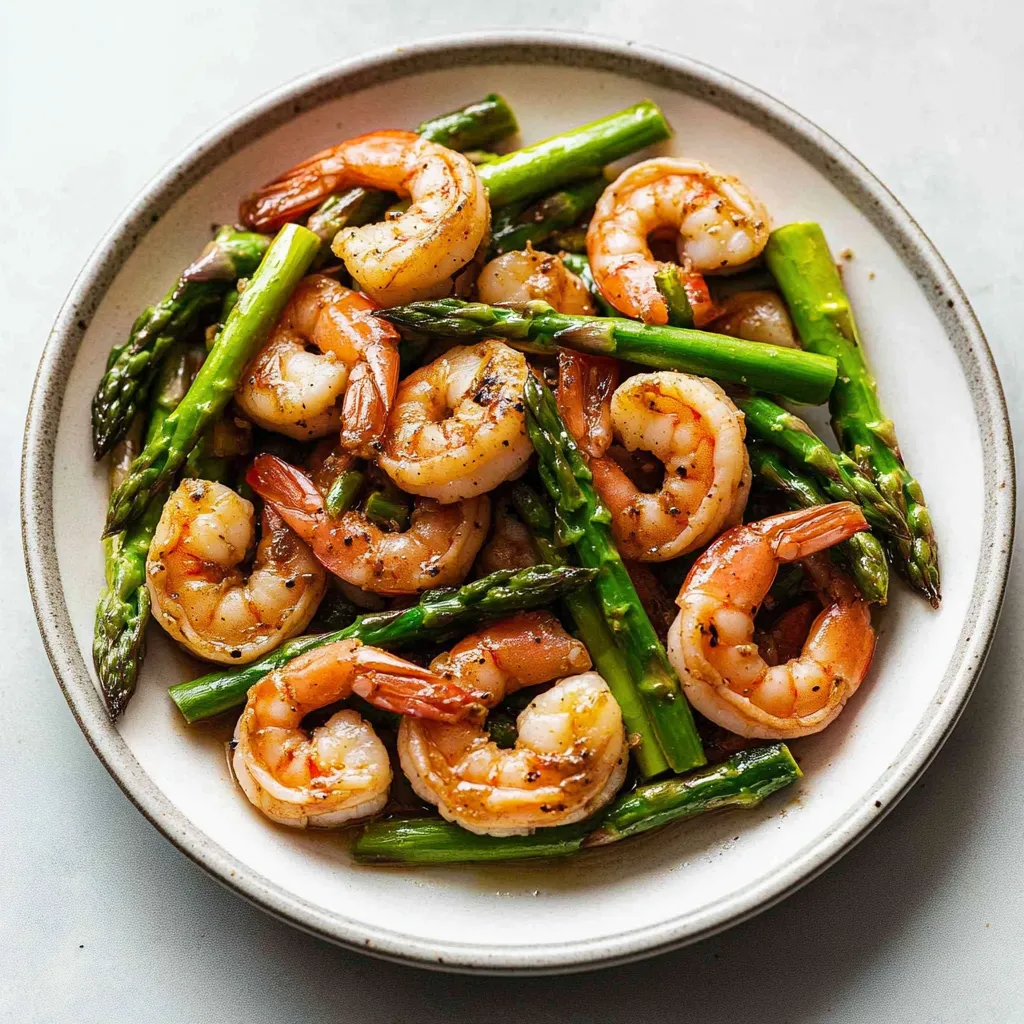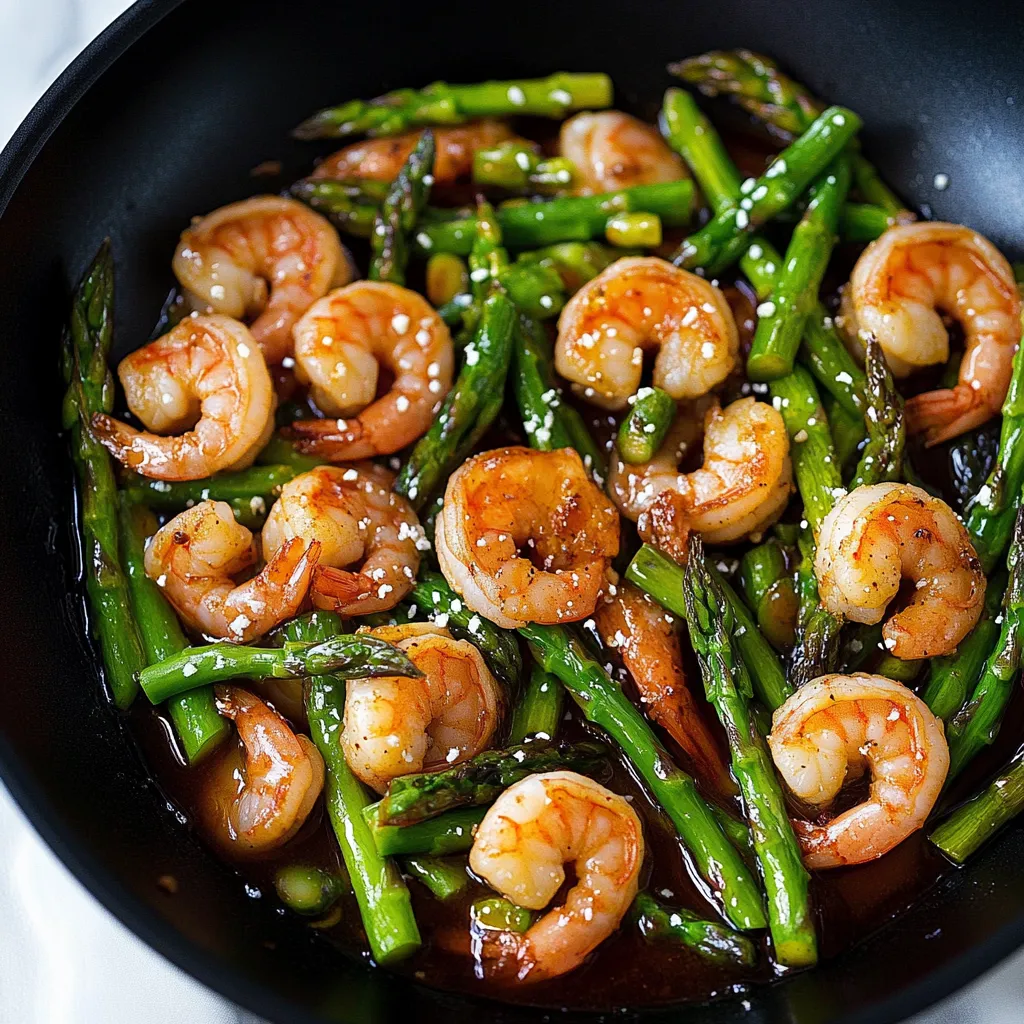 Pin it
Pin it
This vibrant shrimp and asparagus stir fry delivers restaurant-quality flavors using just eight simple ingredients that come together in under 20 minutes. The combination of plump, juicy shrimp with crisp-tender asparagus creates the perfect contrast of textures, while fresh ginger and garlic provide aromatic depth that transforms these humble ingredients into something truly special. Unlike complicated stir-fry recipes that require multiple sauces and hard-to-find ingredients, this dish relies on the pure, clean flavors of oyster sauce to let the natural sweetness of the shrimp and the fresh taste of asparagus shine through.
I discovered this recipe during asparagus season when I had beautiful spears from the farmers market and needed something quick but impressive for a weeknight dinner. The first time I made it, I was amazed at how such simple ingredients could create something that tasted so sophisticated and flavorful. Now it's become my go-to whenever I want to prove that healthy eating doesn't mean sacrificing taste.
Essential Ingredients and Selection Tips
- Large shrimp (16/20 count): Choose shrimp that smell like the ocean, not fishy; properly deveined shrimp prevents any gritty texture that can ruin the dish
- Fresh asparagus: Select spears with tight, compact tips and smooth, bright green stalks; avoid any with woody or dried-out ends
- Fresh ginger: Look for smooth, tight skin without wrinkles; fresh ginger provides bright, spicy heat that ground ginger simply cannot match
- Fresh garlic: Choose firm, plump cloves without green shoots; the generous amount called for creates the aromatic foundation that makes this dish special
- High-quality oyster sauce: This thick, savory-sweet sauce provides all the umami depth you need; look for brands without artificial additives
- Avocado oil: The high smoke point makes it perfect for the high-heat cooking that stir-fries require; neutral flavor won't compete with the other ingredients
- Red pepper flakes: Use within a year for maximum heat and flavor; these add just enough warmth to complement the ginger without overwhelming
The secret to perfect stir-fry is having everything prepped and ready before you start cooking, since the actual cooking happens very quickly over high heat.
Detailed Step-by-Step Instructions
- Step 1: Prepare all ingredients completely:
- Peel and devein the shrimp thoroughly, making sure to remove that dark vein running down the back - rinse and pat them completely dry with paper towels. Trim the woody ends from the asparagus and cut the spears diagonally into 2-inch pieces for the best presentation and even cooking. Mince the ginger and garlic very finely so they distribute evenly throughout the dish.
- Step 2: Heat the cooking vessel properly:
- Place your wok or large skillet over high heat and let it get very hot - this is crucial for proper stir-fry technique. You'll know it's ready when a drop of water immediately sizzles and evaporates. Add 1 tablespoon of avocado oil and swirl to coat the bottom of the pan completely.
- Step 3: Create the aromatic base:
- Add the minced garlic to the hot oil and stir constantly for 15-20 seconds until fragrant but not browned - burned garlic will make the entire dish bitter. The garlic should release its aroma but remain pale golden in color.
- Step 4: Cook the shrimp partially:
- Add the cleaned shrimp, red pepper flakes, and a pinch of salt to the pan. Stir-fry for 2-3 minutes until the shrimp just begin to turn pink and curl slightly - they should be about 70% cooked through. Remove the shrimp immediately to a clean plate and set aside, as they'll finish cooking when returned to the pan later.
- Step 5: Prepare for the asparagus:
- Add the remaining tablespoon of avocado oil to the same pan, followed by the minced ginger. Stir constantly for 10-15 seconds to release the ginger's oils and create that characteristic spicy-sweet aroma that defines good stir-fry.
- Step 6: Cook the asparagus perfectly:
- Add the cut asparagus pieces to the pan and stir-fry for exactly 3 minutes, tossing constantly to ensure even cooking. The asparagus should turn bright green and become crisp-tender - it should have a slight bite but not be raw or woody.
- Step 7: Combine and finish:
- Return the partially cooked shrimp to the pan along with 2 tablespoons of water and 3 tablespoons of oyster sauce. Toss everything together quickly and continue cooking for 1-2 minutes until the shrimp are completely cooked through (they'll be opaque and pink) and the sauce coats everything evenly.
- Step 8: Final seasoning and serve:
- Taste and adjust seasoning with additional salt if needed, though the oyster sauce usually provides enough saltiness. Serve immediately while the asparagus is still crisp and the shrimp are at their most tender.
 Pin it
Pin it
The most critical technique is maintaining high heat throughout the entire cooking process and never stopping the motion - constant stirring and tossing prevents burning while ensuring even cooking and proper flavor development.
This recipe has become my favorite example of how simple ingredients, when treated with proper technique, can create something that feels much more complex and sophisticated than the sum of its parts. My family always comments on how restaurant-like this tastes, which makes me proud that healthy home cooking can be just as satisfying as takeout.
Understanding Stir-Fry Heat Control and Timing
Successful stir-frying depends entirely on understanding heat management and precise timing, as the entire cooking process happens very quickly at high temperatures. The wok or pan must be extremely hot before adding any ingredients to achieve the characteristic "wok hei" - that slightly smoky, seared flavor that defines authentic stir-fries. Each ingredient is added at a specific moment based on its cooking time requirements, with aromatics going first to build the flavor base, followed by proteins that need partial cooking, then vegetables that cook quickly, and finally sauces that just need to heat through and coat everything.
Shrimp Cooking Techniques and Texture Control
Properly cooking shrimp requires understanding their unique protein structure and how quickly they can go from perfectly tender to rubbery. The partial cooking method used here ensures the shrimp maintain their tender texture while picking up flavor from the aromatics. Shrimp continue cooking even after removal from heat due to residual heat, which is why they're removed while still slightly underdone. The second cooking phase with the asparagus and sauce finishes them perfectly without any risk of overcooking, resulting in plump, juicy shrimp with ideal texture.
Asparagus Selection and Preparation Methods
Fresh asparagus quality varies dramatically based on season and storage, making proper selection crucial for this recipe's success. In-season asparagus has naturally sweet flavor and tender texture that complements the shrimp perfectly, while out-of-season asparagus can be woody and bitter. The diagonal cutting technique not only looks more professional but also creates more surface area for better sauce adhesion and more even cooking. The three-minute cooking time is precisely calculated to achieve that perfect crisp-tender texture that provides satisfying crunch without being raw.
Sauce Integration and Flavor Building
The beauty of this recipe lies in its sauce simplicity - oyster sauce provides all the complex umami flavors needed without requiring multiple ingredients. The small amount of water helps the thick oyster sauce distribute evenly and creates just enough liquid to coat all ingredients without making the dish soupy. The timing of sauce addition is critical - it goes in at the end when everything is nearly cooked, allowing it to heat through and coat the ingredients without reducing too much or becoming sticky.
Aromatics and Their Flavor Contributions
The generous amounts of fresh ginger and garlic called for in this recipe create the aromatic foundation that elevates simple ingredients into something special. Fresh ginger provides both heat and sweetness with complex flavor compounds that dried ginger cannot match, while fresh garlic contributes pungent depth that mellows during cooking. The technique of cooking these aromatics separately from the proteins allows their flavors to develop fully and infuse the cooking oil, which then carries those flavors throughout the entire dish.
This shrimp and asparagus stir-fry has become my perfect example of how understanding basic cooking principles can transform simple ingredients into something that tastes sophisticated and restaurant-quality. Every time I make it, I'm reminded that great cooking often comes down to respecting each ingredient's unique properties and applying proper technique rather than relying on complicated recipes or exotic ingredients.
Frequently Asked Questions
- → Can I use frozen shrimp for this recipe?
- Yes, just make sure to thaw the shrimp completely and pat them dry before cooking to avoid excess water in the pan.
- → What can I substitute for oyster sauce?
- You can use soy sauce mixed with a little honey, or teriyaki sauce as a substitute for oyster sauce.
- → How do I know when the asparagus is cooked properly?
- The asparagus should be bright green and tender-crisp when you bite into it, not soft or mushy.
- → Can I make this recipe ahead of time?
- This stir fry is best served immediately, but you can prep all ingredients beforehand and cook when ready to eat.
- → What other vegetables work well in this stir fry?
- Bell peppers, snap peas, broccoli, or carrots would all work great as substitutes or additions to the asparagus.
- → How long should I cook the shrimp?
- Cook shrimp for 2-3 minutes until they turn pink. Don't overcook them or they'll become tough and rubbery.
